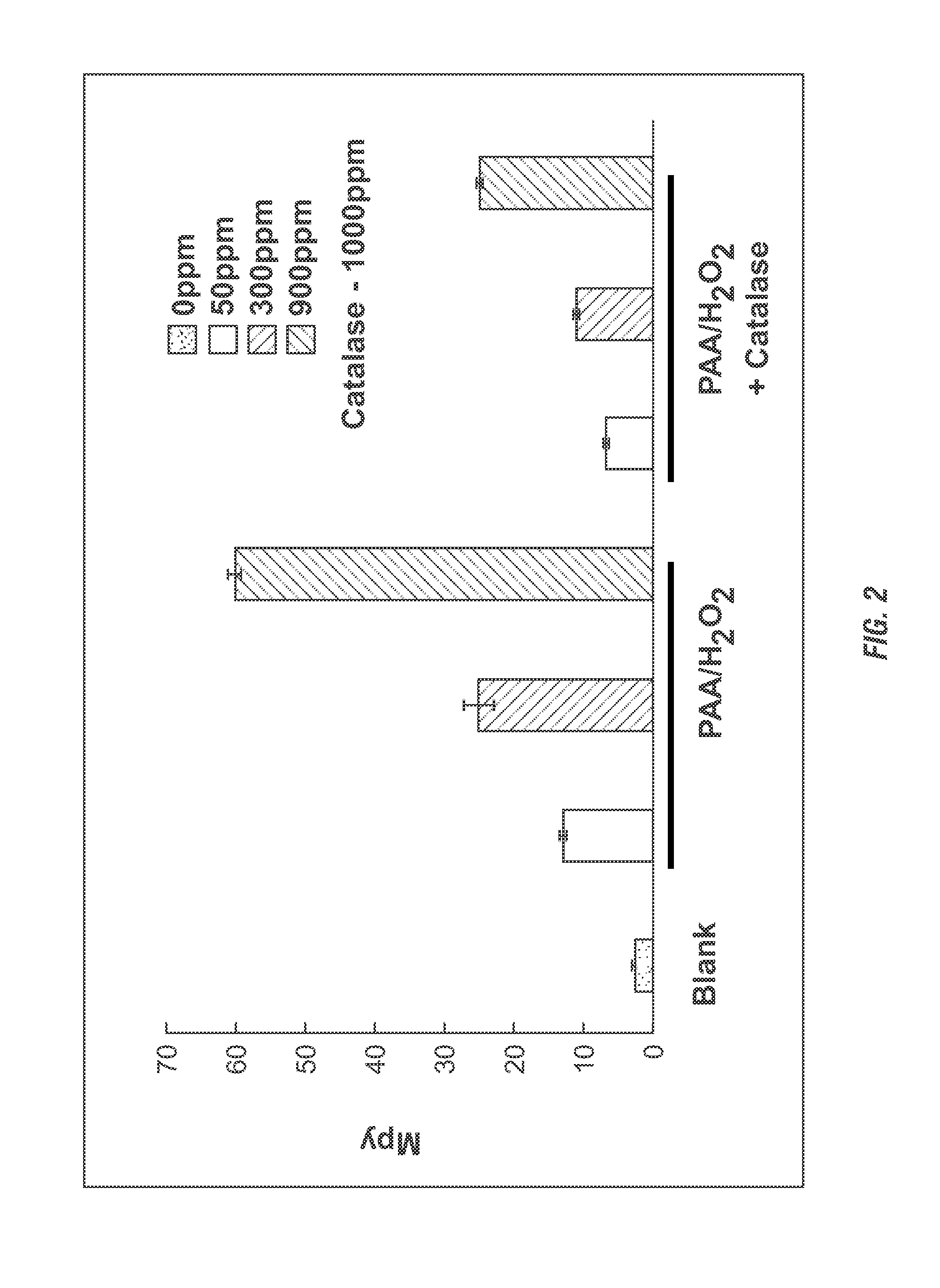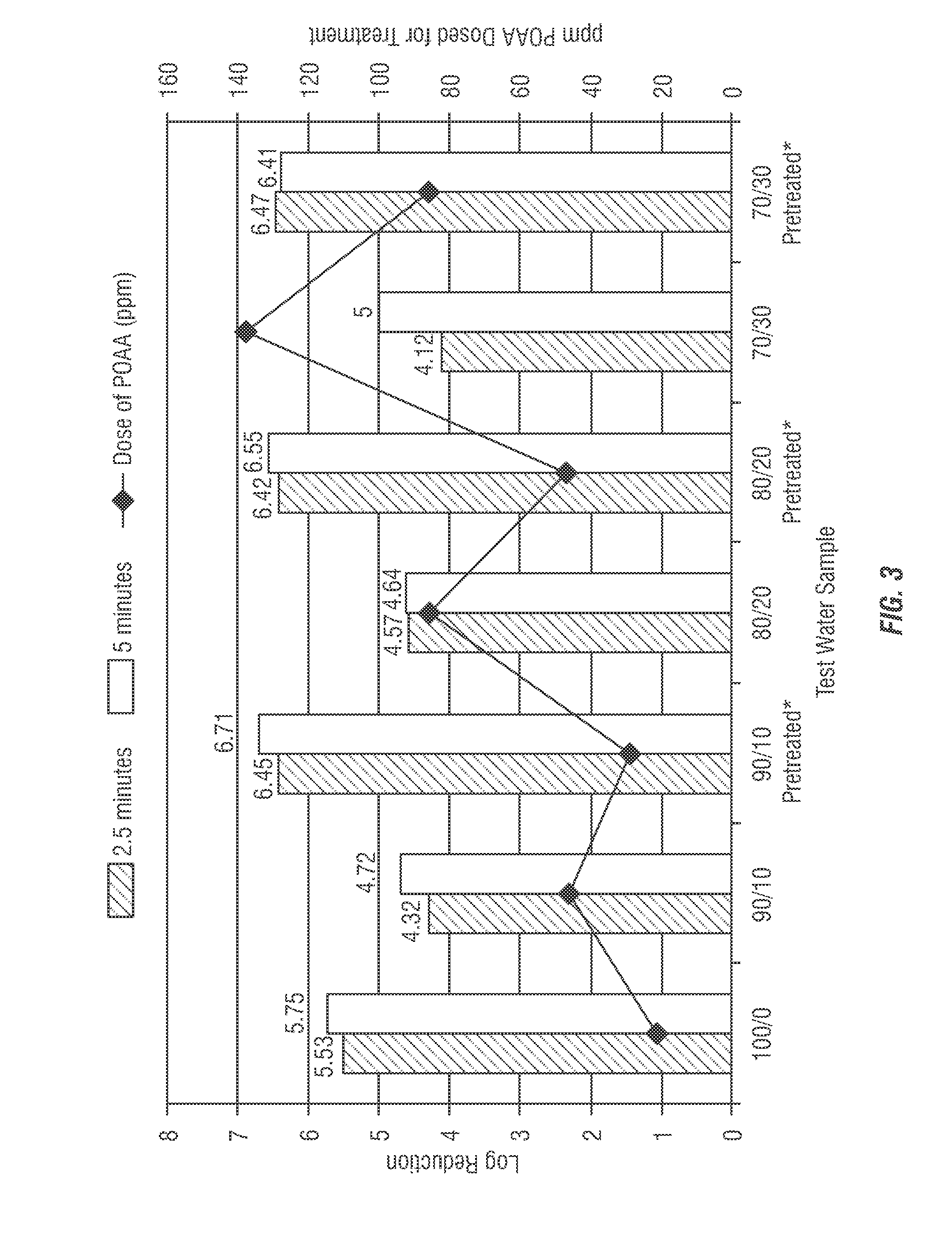Use of peracetic acid/hydrogen peroxide and peroxide-reducing enzymes for treatment of drilling fluids, frac fluids, flowback water and disposal water
a technology of peracetic acid and hydroxide, which is applied in the direction of treatment water, disinfection, and borehole/well accessories, etc., can solve the problems of low environmental footprint, difficult use of peracids, and limitations of water treatment methods for use of peracids, and achieve effective antimicrobial effects
- Summary
- Abstract
- Description
- Claims
- Application Information
AI Technical Summary
Benefits of technology
Problems solved by technology
Method used
Image
Examples
example 1
[0210]Corrosion test were conducted. Corrosion rates were determined by a wheel box test, using bottles on a wheel in an oven. Each bottle contained a 1018 carbon steel coupon used for weight loss analysis upon completion of the test. The test was conducted using produced water (e.g. recycled water) from an oil / gas well and deionized water. The test was run at room temperature and in triplicates. The average corrosion rates were compared to blank samples (no chemical added). PAA / H2O2 was dosed at 50, 300 and 900 ppm. Catalase was added at 1000 ppm. The test duration was 24 hours.
[0211]Results. The results from the corrosion tests for produced and deionized water are shown in FIG. 1. For a produced water sample, addition of 1000 ppm catalase to the PAA / H2O2 treatment decreased the corrosion rates of the 1018 carbon steel by approximately 30-50% (FIG. 1). In deionized water the reduction in corrosion rates reached almost 60% (FIG. 2).
example 2
[0212]An evaluation of friction reducer interference was conducted. Viscosity measurements were obtained using a FANN Model 35 Viscometer. A total of 600 ml of tap water containing a friction reducer was treated with 200 ppm and 1000 ppm of peracetic acid with and without catalase. The mixture was blended for 15 seconds with a Hamilton Beach hand mixer and viscosity was measured at 300 rpm, room temperature. Viscosity values are reported in centipoise (cP).
[0213]Results. Table 1 shows the impact of PAA / H2O2 on friction reducers within a water source for oil / gas recovery, with and without the addition of catalase. A negative effect of the PAA / H2O2 was observed on both friction reducers. However, the effect was reduced in all cases following treatment with catalase indicating the addition of catalase to remove H2O2 reduces any negative impact of PAA / H2O2 on the friction reducers.
TABLE 1With(Yes) / ReadingReadingFrictionWithoutbeforeafterBiocideReducer(NO)chem-chem-Differ-dosage(1 gt)cat...
example 3
[0214]The impact of water pretreatment with 500 ppm of the EnviroSan product (75 ppm POAA) on micro efficacy in various fracking water mixtures were evaluated. The example represents a baseline data set of various water treatment options according to the invention. Table 2 and FIG. 3 show the average log reduction in various slick water treatments with varying ppm PAA (without any catalase treatment or pretreatment), representing a baseline data set.
TABLE 2Avg. Log10ReductionHolding TankPercentageSlick Water2.5PretreatmentReuse H2OTreatmentminutes5 minutesNone0%22 ppmNO5.535.75POAACatalase75 ppm PAA10%29 ppmNO6.456.71POAACatalaseNone36 ppm4.324.72POAA75 ppm PAA20%47 ppmNO6.426.55PAACatalaseNone86 ppm4.574.64POAA75 ppm PAA30%86 ppmNO6.476.41POAACatalaseNone138 ppm 4.125.00POAA
FIG. 3 shows the increasing amount of POAA required in tested water samples having increased amounts of produced water (e.g. reused water).
PUM
| Property | Measurement | Unit |
|---|---|---|
| temperature | aaaaa | aaaaa |
| temperatures | aaaaa | aaaaa |
| volume | aaaaa | aaaaa |
Abstract
Description
Claims
Application Information
 Login to View More
Login to View More - R&D
- Intellectual Property
- Life Sciences
- Materials
- Tech Scout
- Unparalleled Data Quality
- Higher Quality Content
- 60% Fewer Hallucinations
Browse by: Latest US Patents, China's latest patents, Technical Efficacy Thesaurus, Application Domain, Technology Topic, Popular Technical Reports.
© 2025 PatSnap. All rights reserved.Legal|Privacy policy|Modern Slavery Act Transparency Statement|Sitemap|About US| Contact US: help@patsnap.com



